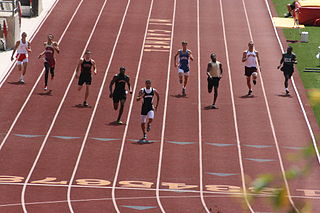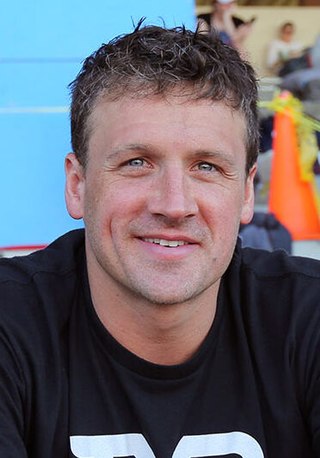
Google Search is a search engine operated by Google. It allows users to search for information on the Internet by entering keywords or phrases. Google Search uses algorithms to analyze and rank websites based on their relevance to the search query. It is the most popular search engine worldwide.

The javelin throw is a track and field event where the javelin, a spear about 2.5 m in length, is thrown as far as possible. The javelin thrower gains momentum by running within a predetermined area. Javelin throwing is an event of both the men's decathlon and the women's heptathlon.

Pole vaulting, also known as pole jumping, is a track and field event in which an athlete uses a long and flexible pole, usually made from fiberglass or carbon fiber, as an aid to jump over a bar. Pole jumping was already practiced by the ancient Egyptians, ancient Greeks and the ancient Irish people, although modern pole vaulting, an athletic contest where height is measured, was first established by the German teacher Johann Christoph Friedrich GutsMuths in the 1790s. It has been a full medal event at the Olympic Games since 1896 for men and since 2000 for women.

The shot put is a track and field event involving "putting" (throwing) a heavy spherical ball—the shot—as far as possible. For men, the sport has been a part of the modern Olympics since their revival (1896), and women's competition began in 1948.

The triple jump, sometimes referred to as the hop, step and jump or the hop, skip and jump, is a track and field event, similar to long jump. As a group, the two events are referred to as the "horizontal jumps". The competitor runs down the track and performs a hop, a bound and then a jump into the sand pit. The triple jump was inspired by the ancient Olympic Games and has been a modern Olympics event since the Games' inception in 1896.

The decathlon is a combined event in athletics consisting of 10 track and field events. The word "decathlon" was formed, in analogy to the word "pentathlon", from Greek δέκα and ἄθλος. Events are held over two consecutive days and the winners are determined by the combined performance in all. Performance is judged on a points system in each event, not by the position achieved. The decathlon is contested mainly by male athletes, while female athletes typically compete in the heptathlon.

A heptathlon is a track and field combined events contest made up of seven events. The name derives from the Greek ἑπτά and ἄθλος. A competitor in a heptathlon is referred to as a heptathlete.

John Felix Anthony Cena is an American actor and professional wrestler. As a wrestler, he has been signed to WWE since 2001, but has performed part-time since 2018 with plans to retire at the end of 2025. A record 16-time world champion as recognized by WWE, he is regarded as one of the greatest professional wrestlers of all time.

The 800 metres, or meters, is a common track running event. It is the shortest commonly run middle-distance running event. The 800 metres is run over two laps of an outdoor (400-metre) track and has been an Olympic event since the first modern games in 1896. During the winter track season the event is usually run by completing four laps of an indoor 200-metre track.

The 400 metres, or 400-meter dash, is a sprint event in track and field competitions. It has been featured in the athletics programme at the Summer Olympics since 1896 for men and since 1964 for women. On a standard outdoor running track, it is one lap around the track. Runners start in staggered positions and race in separate lanes for the entire course. In many countries, athletes previously competed in the 440-yard dash (402.336 m)—which is a quarter of a mile and was referred to as the "quarter-mile"—instead of the 400 m (437.445 yards), though this distance is now obsolete.

The 100 metres, or 100-meter dash, is a sprint race in track and field competitions. The shortest common outdoor running distance, the 100-meter (109.36 yd) dash is one of the most popular and prestigious events in the sport of athletics. It has been contested at the Summer Olympics since 1896 for men and since 1928 for women. The inaugural World Championships were in 1983.

The 200 metres, or 200-meter dash, is a sprint running event. On an outdoor 400 metre racetrack, the race begins on the curve and ends on the home straight, so a combination of techniques is needed to successfully run the race. A slightly shorter race, called the stadion and run on a straight track, was the first recorded event at the ancient Olympic Games. The 200 m places more emphasis on speed endurance than shorter sprint distances as athletes predominantly rely on anaerobic energy system during the 200 m sprint. Similarly to other sprint distances, the 200 m begins from the starting blocks. When the sprinters adopt the 'set' position in the blocks they are able to adopt a more efficient starting posture and isometrically preload their muscles. This enables them to stride forwards more powerfully when the race begins and start faster.

The 1500 metres or 1,500-metre run is the foremost middle distance track event in athletics. The distance has been contested at the Summer Olympics since 1896 and the World Championships in Athletics since 1983. It is equivalent to 1.5 kilometers or approximately 15⁄16 miles. The event is closely associated with its slightly longer cousin, the mile race, from which it derives its nickname "the metric mile".

Ryan Steven Lochte is an American former competition swimmer and 12-time Olympic medalist. He is the third-most decorated swimmer in Olympic history measured by total number of medals, behind only Michael Phelps and Katie Ledecky. Lochte's seven individual Olympic medals rank second in history in men's swimming, tied for second among all Olympic swimmers. He currently holds the world records in the 200-meter individual medley. As part of the American teams, he also holds the world record in the 4×200-meter freestyle and 4×100-meter freestyle (mixed) relay.

Michael Fred Phelps II is an American former competitive swimmer. He is the most successful and most decorated Olympian of all time with a total of 28 medals. Phelps also holds the all-time records for Olympic gold medals (23), Olympic gold medals in individual events (13), and Olympic medals in individual events (16). At the 2004 Summer Olympics in Athens, Phelps tied the record of eight medals of any color at a single Games, held by gymnast Alexander Dityatin, by winning six gold and two bronze medals. Four years later, when he won eight gold medals at the 2008 Beijing Games, he broke fellow American swimmer Mark Spitz's 1972 record of seven first-place finishes at any single Olympic Games. At the 2012 Summer Olympics in London, Phelps won four gold and two silver medals, and at the 2016 Summer Olympics in Rio de Janeiro, he won five gold medals and one silver. This made him the most successful athlete of the Games for the fourth Olympics in a row.

The 20 kilometre race walk is an Olympic athletics event that is competed by both men and women. The racewalking event is competed as a road race. Athletes must always keep in contact with the ground and the supporting leg must remain straight until the raised leg passes it.
















